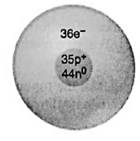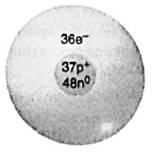
a)
Interpretation:The name of the parent

Concept introduction:Mass number
The period number is the number of horizontal rows in a periodic table. There are 7 periods in a periodic table.
The charge on the atom is the difference between the protons and electrons.If there are excess electrons on the atom then the ion will be negatively charged. If there are excess protons on the atom then the ion will be positively charged.
b)
Interpretation:Name of the parent atom, its mass number and its group and period number of the below mentioned ionic depiction should be given.

Concept introduction:Mass number
The period number is the number of horizontal rows in a periodic table. There are 7 periods in a periodic table.
The charge on the atom is the difference between the protons and electrons.If there are excess electrons on the atom then the ion will be negatively charged. If there are excess protons on the atom then the ion will be positively charged.
c)
Interpretation:Name of the parent atom, its mass number and its group and period number of the below mentioned ionic depiction should be given.

Concept introduction:Mass number
The period number is the number of horizontal rows in a periodic table. There are 7 periods in a periodic table.
The charge on the atom is the difference between the protons and electrons.If there are excess electrons on the atom then the ion will be negatively charged. If there are excess protons on the atom then the ion will be positively charged.
Want to see the full answer?
Check out a sample textbook solution
Chapter 2 Solutions
Principles of General Chemistry
- For each ionic depiction, give the name of the parent atom, its mass number, and its group and period numbers:arrow_forwardGive the names of appropriate element for (a)~(d) in the passages below. (1) (a) and (b) are elements that belong to period 5 and 6 in the periodic table, respectively. Both simple substances are solid under room temperature. To an aqueous solution containing cations of (a) and (b), dilute hydrochloric acid was dropped to produce white precipitate. Upon rinsing with boiling water, the precipitate was partially dissolved. (2) Both (c) and (d) are elements that produce stable trivalent cations in an aqueous solution. To an aqueous solution containing (c) and (d) as trivalent cations, aqueous ammonia was dropped to produce a gel-like precipitate. Upon the addition of concentrated aqueous sodium hydroxide, the precipitate was partially dissolved and the majority of (c ) was transferred to the supernatant.arrow_forwardgive the first compound prepared of noble gases.arrow_forward
- Convert the composition of the following alloy from atom percent to weight percent (a) 44.9 at% of silver, (b) 46.3 at% of gold, and (c) 8.8 at% of copper. The atomic weights for silver, gold, and copper are 107.87, 196.97, and 63.55 g/mol, respectively.arrow_forwardPredict the charges of the monoatomic ions formed by each main-group element.(a) N(b) Rbarrow_forwardMany important fertilizers are ionic compounds thatcontain the elements nitrogen, phosphorus, and potassium because these are frequently the limiting plantgrowth nutrients in soil.(a) Write the chemical formulas for the following chemical fertilizers: ammonium phosphate, potassiumnitrate, ammonium sulfate.(b) Calculate the mass percentage of nitrogen, phosphorus, and potassium for each of the compounds inpart (a).arrow_forward
- Fill in the table below by providing the missing information - name or formula. Compounds 1-10 are ionic compounds, compounds 11-15 are molecular. Name Chemical (compound) formula Cr, (CrO,), Ag, HPO, Co (MnO4)2 Sn, (PO3)4 Cu,N Barium nitrite Ammonium dichromate Strontium phosphide Iron(III) hypobromite Cadmium perfluorate SiO SiBr, BrF, As,S, P,O3arrow_forwardWhich of the following substances always has the same proportion (i.e. a fixed ratio) of its constituent elements? (1) Air (2) pure calcium carbonate (3) Brass (4) Saltwater (5) Woodarrow_forwardDetermine the empirical formula of each of the following compounds. (Type your answer using the format CH4 for CH4 and list the elements in the same order as they are mentioned in the problem.) (a) 0.063 mol chlorine atoms combined with 0.22 mol oxygen atoms(b) 2.45 g silicon combined with 12.4 g chlorine(c) 42.9 mass % carbon and 57.1 mass % oxygenarrow_forward
- How many atoms of chlorine (CI) are present in 0.072 g of FeCI,? Given that ; Fe= 56 g /mol, Cl= 35.5 g/mol NA= 6.022x 10 atom mol.arrow_forwardElement A is an atomic element, and element B is a diatomic molecular element. Using circles to represent atoms of A and squares to represent atoms of B, draw molecular-level views of each element.arrow_forwardA compound Y containing carbon, hydrogen and oxygen only have the following composition by mass:C: 40.0% ; H: 6.7% ; O: 53.3%(a) Calculate the empirical formula of the compound. (Relative atomic masses: H =1.0, C = 12.0, O = 16.0) (b) Given that the relative molecular mass of compound Y is 180. Find its molecular formula.arrow_forward
 Chemistry & Chemical ReactivityChemistryISBN:9781337399074Author:John C. Kotz, Paul M. Treichel, John Townsend, David TreichelPublisher:Cengage Learning
Chemistry & Chemical ReactivityChemistryISBN:9781337399074Author:John C. Kotz, Paul M. Treichel, John Townsend, David TreichelPublisher:Cengage Learning Chemistry & Chemical ReactivityChemistryISBN:9781133949640Author:John C. Kotz, Paul M. Treichel, John Townsend, David TreichelPublisher:Cengage Learning
Chemistry & Chemical ReactivityChemistryISBN:9781133949640Author:John C. Kotz, Paul M. Treichel, John Townsend, David TreichelPublisher:Cengage Learning World of Chemistry, 3rd editionChemistryISBN:9781133109655Author:Steven S. Zumdahl, Susan L. Zumdahl, Donald J. DeCostePublisher:Brooks / Cole / Cengage Learning
World of Chemistry, 3rd editionChemistryISBN:9781133109655Author:Steven S. Zumdahl, Susan L. Zumdahl, Donald J. DeCostePublisher:Brooks / Cole / Cengage Learning Chemistry for Today: General, Organic, and Bioche...ChemistryISBN:9781305960060Author:Spencer L. Seager, Michael R. Slabaugh, Maren S. HansenPublisher:Cengage Learning
Chemistry for Today: General, Organic, and Bioche...ChemistryISBN:9781305960060Author:Spencer L. Seager, Michael R. Slabaugh, Maren S. HansenPublisher:Cengage Learning Chemistry: The Molecular ScienceChemistryISBN:9781285199047Author:John W. Moore, Conrad L. StanitskiPublisher:Cengage Learning
Chemistry: The Molecular ScienceChemistryISBN:9781285199047Author:John W. Moore, Conrad L. StanitskiPublisher:Cengage Learning Introductory Chemistry: An Active Learning Approa...ChemistryISBN:9781305079250Author:Mark S. Cracolice, Ed PetersPublisher:Cengage Learning
Introductory Chemistry: An Active Learning Approa...ChemistryISBN:9781305079250Author:Mark S. Cracolice, Ed PetersPublisher:Cengage Learning





